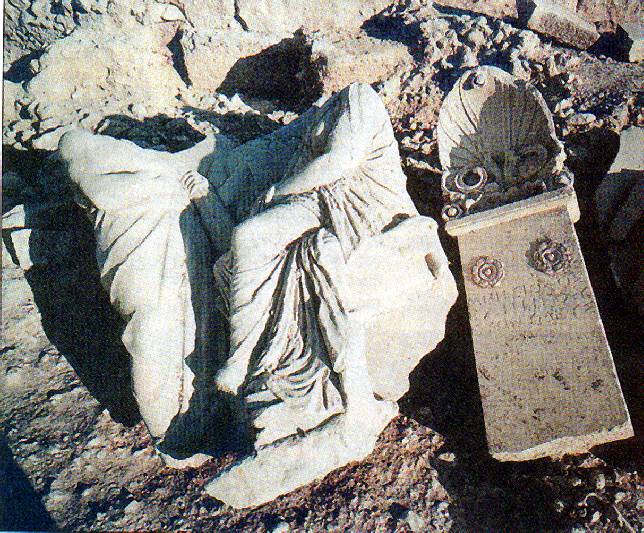
ANISTORITON: Archaeology News
Volume 8, September 2004, Section A043
http://www.anistor.co.hol.gr/index.htm
Eyonymon Cemetery in Athens
 During the excavations for the new Athens tramway system a grave stone and grave statues were brought to light. They have proven the exact place in Hellenicon, a southern suburb of Athens, where the cemetery of the ancient demos (district) of Eyonymon was located.
During the excavations for the new Athens tramway system a grave stone and grave statues were brought to light. They have proven the exact place in Hellenicon, a southern suburb of Athens, where the cemetery of the ancient demos (district) of Eyonymon was located.
Zeus Shrine in Dion
A shrine devoted to Zeus and dating to the 2nd c. BCE was uncovered in Dion, Macedonia, Greece. The exciting findings include marble stelae inscribed with Zeus eagle. This symbol had been used by the Macedonians since the 4th c. BCE.
The Rafina Shrine
In Rafina, Attica, a 600 BCE small shrine. It measures 8 by 3 meters and it is divided into two rooms. It is interesting that in exactly the same area archaeologists excavated the foundations of a 1600 BCE building.
Warriors's Gold Masks from Pella
 Excavations in Pella, Macedonia, Greece, have yielded 396 tombs from the seventh to the early third century BC and more than 5,000 finds. Among them are 80 gold-bedecked warriors dressed like heroes in their armor, and beside them their wives, revealing that there were Macedonians in Pella two centuries before the time of Phillip and Alexander.
Their gold grave costumes, made by local Macedonian metal workers, bear witness to the wealth, noble origins, heroic stature and leading role of aristocratic Macedonian families in the second half of the sixth century BC.
Excavations in Pella, Macedonia, Greece, have yielded 396 tombs from the seventh to the early third century BC and more than 5,000 finds. Among them are 80 gold-bedecked warriors dressed like heroes in their armor, and beside them their wives, revealing that there were Macedonians in Pella two centuries before the time of Phillip and Alexander.
Their gold grave costumes, made by local Macedonian metal workers, bear witness to the wealth, noble origins, heroic stature and leading role of aristocratic Macedonian families in the second half of the sixth century BC.
The warriors, buried in full armor, and their wives in gold funeral garments resembling their wedding dresses, indicate a high living standard and social status, and provide valuable evidence of funeral rites and beliefs about the pursuits of the dead in the “other world” during antiquity.
Gold masks, breastplates, foil and other grave ornaments adorning clothes, shoes, helmets, shields, swords and spears, and Macedonian knives decorated with gold sheets or rosettes, gold jewelry and metal likenesses of farm carts, furniture and spits with their holders accompanied the dead in their simple pit graves.
The gold finds, untouched by time or grave robbers, are slowly being dug up by archaeologists Anastasia Chrysostomou and Pavlos Chrystomos from the 17th Ephorate of Prehistorical and Classical Antiquities in Edessa.









 During the excavations for the new Athens tramway system a grave stone and grave statues were brought to light. They have proven the exact place in Hellenicon, a southern suburb of Athens, where the cemetery of the ancient demos (district) of Eyonymon was located.
During the excavations for the new Athens tramway system a grave stone and grave statues were brought to light. They have proven the exact place in Hellenicon, a southern suburb of Athens, where the cemetery of the ancient demos (district) of Eyonymon was located. Excavations in Pella, Macedonia, Greece, have yielded 396 tombs from the seventh to the early third century BC and more than 5,000 finds. Among them are 80 gold-bedecked warriors dressed like heroes in their armor, and beside them their wives, revealing that there were Macedonians in Pella two centuries before the time of Phillip and Alexander.
Their gold grave costumes, made by local Macedonian metal workers, bear witness to the wealth, noble origins, heroic stature and leading role of aristocratic Macedonian families in the second half of the sixth century BC.
Excavations in Pella, Macedonia, Greece, have yielded 396 tombs from the seventh to the early third century BC and more than 5,000 finds. Among them are 80 gold-bedecked warriors dressed like heroes in their armor, and beside them their wives, revealing that there were Macedonians in Pella two centuries before the time of Phillip and Alexander.
Their gold grave costumes, made by local Macedonian metal workers, bear witness to the wealth, noble origins, heroic stature and leading role of aristocratic Macedonian families in the second half of the sixth century BC.